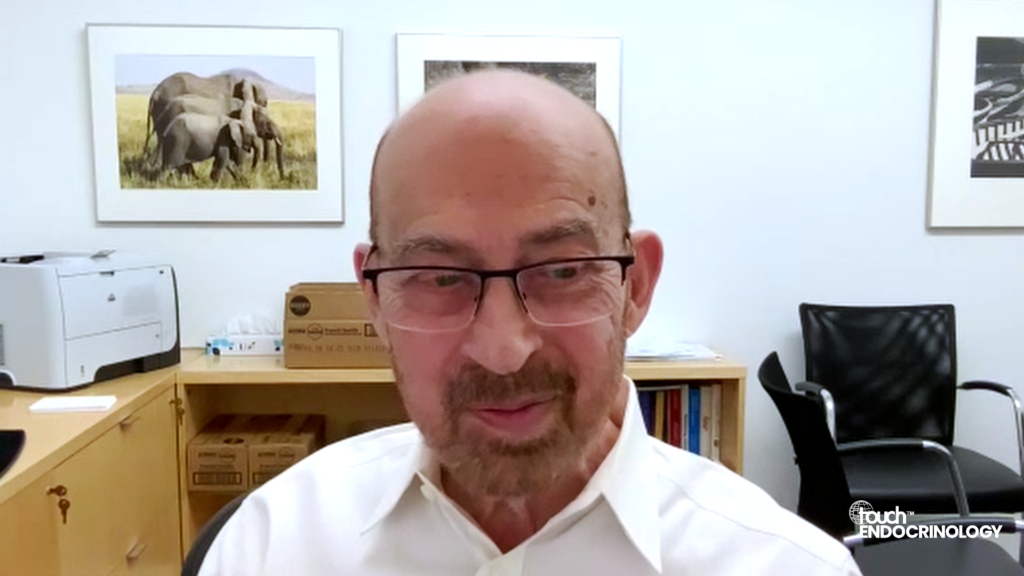Prof. Chantal Mathieu (Katholieke Universiteit Leuven, Belgium) provides her highlights from the ADA 83rd Scientific Sessions, 2023 including Teplizumab, an anti-CD3 monoclonal antibody, which was the first disease modifying therapy that delays the progression from stage 2 to stage 3 type 1 diabetes and was FDA approved in November 2022; Orforglipron, an oral, non-peptide glucagon-like peptide-1 (GLP-1) receptor agonist that is in development for type 2 diabetes and obesity and how continuous occupation of glucagon can be used in the treatment of type 2 diabetes as it gives you a completely different clinical picture from the intermittent glucagon action.
Questions:
- What are the key clinical highlights from ADA 2023? (0:14)
Disclosures: Chantal Mathieu serves or has served on the advisory panel for Novo Nordisk, Sanofi, Merck Sharp and Dohme Ltd., Eli Lilly and Company, Novartis, AstraZeneca, Boehringer Ingelheim, Roche, Medtronic, ActoBio Therapeutics, Pfizer, Imcyse, Insulet, Zealand Pharma, Avotres, Mannkind, Sandoz and Vertex.
Support: Interview and filming supported by Touch Medical Media. Interview conducted by Shanice Allen.
Filmed as a highlight of ADA 2023.
Transcript
I’m Chantal Mathieu. I’m an endocrinologist at the University of Leuven, in Leuven, Belgium.
What are the key clinical highlights from ADA 2023?
This year’s scientific sessions of the American Diabetes Association in San Diego were amazing. They were amazing for clinical content, but they were also amazing for the whole positive atmosphere happening there, with really the feeling that we have now is these modifying therapies in our hands in many different forms of diabetes. First of all, I will start with a topic that is very close to my heart, namely type one diabetes, where in November of 2022, the FDA approved the first disease-modifying therapy to delay progression from “stage two” type one diabetes to “stage three” type one diabetes being from people who have autoantibodies and just dysglycemia to overt clinical type one diabetes. And that product is teplizumab, a monoclonal antibody, directed against CD3-carrying T lymphocytes. And so this therapy, a treatment of twelve to fourteen days IV treatment in people with Stage two type one can delay the progression to clinical type one diabetes by about two to three years. And so this really has opened the gate to a lot of optimism to other disease-modifying therapies coming along being presented at ADA, and also the whole debate on whether it is time now to really actively screen people for preclinical type one diabetes by the presence auto antibodies. And so now we’re even discussing screening general population. And so that was one for me of the big clinical highlights in ADA. But also in type two diabetes we have now disease modifying therapies, therapies that really enter fear with the course of the disease and can even bring type two diabetes in in remission. Indeed, that was going on in ADA scientific sessions, this year was really all about incretin based therapies, now moving from peptide based interventions to small molecule interventions. So we had, for instance, very interesting presentations on Or4 Gipron. So add quite a difficult name, but so a new molecule still in stage two, but a new molecule interfering directly with the GLP one receptor, so a GLP one receptor agonist, but a small molecule, and thus an oral therapy. And an oral therapy that is not disturbed by intake of food, by intake of other medication, etcetera. And so there was such an excitement because this Or4 Gipron, can also only bring down hemoglobin a1c levels up to two percent depending on the dose, but also bring down weight in individuals with type two diabetes to twenty even higher percentages of weight loss. So a lot of enthusiasm. Of course, stage two, some side effects being reported, mainly gastrointestinal side effects which were to be expected, but so there we will have to see in phase three trials whether the balance of efficacy and side effects is really worthwhile. And then in the same team, also many, many new agents based on a more standard concept of peptide based incretin therapy combinations of GLP-one receptor agonism and GIP receptor agonism with the one product already in clinical practice in many countries namely tirzepatide, a lot of data being presented there, post hoc analyses of the surpassed program indicating data on stability of glucose control, etcetera, but also many other new molecules coming out or new combinations of incretin based therapies and also bringing in other hormones like glucagon. Interesting, treating type two diabetes, with glucagon, the hormone that we know as the insulin-counteracting hormone. Well, Professor Matias Chipp received the balancing medal. He gave an outstanding lecture at the scientific sessions where he clearly demonstrated that the way you administer glucagon, the continuous occupation of the receptor gives you a completely different clinical picture from the intramatement glucagon action. And so now, we are looking at combinations of GLP one and glucagon GLP one, GIP, and glucagon And so all of these combinations really bring forward agents that are amazing. So one of the presentations was, for instance, on Retatrutide where data in obesity and in type two diabetes were presented both published in the New England Journal of Medicine, now presenting again in the people with type two diabetes, drops in hemoglobin a1c by two percent, and weight loss in people with type two diabetes, again above twenty percent and in those without type two diabetes above twenty five percent – amazing data. I myself was involved in another presentation on these types of combinations with cagrilintide and semaglutide, Cagrissema, the study was called, again, showing very impressive lowering in hemoglobin a1c and in body weight. So if you ask me to summarize the scientific sessions of eighty eight this year, an enormous positive vibe that we are really at the brink of disease modification in type one, in type two. And that we really have now robust therapies in type two diabetes to address one of the culprits of type two diabetes namely obesity. So a lot of good vibes and what is important? If you come to an EASD in October, in Hamburg, we will be able to come back on these data and explore even more data on these exciting molecules and also dive in-depth on the mechanisms of action. So I welcome everybody to EASD in Hamburg.
Subtitles and transcript are autogenerated.













